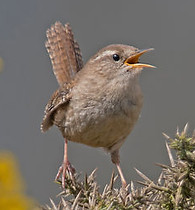Birds that prefer open-fronted boxes
Pied Wagtail Motacilla alba

The Pied Wagtail often lives close to water – but that doesn’t exclude them from nesting in the middle of our largest city centres. They use a wide variety of nest sites, from drainpipes to farm machinery. Nestboxes are best sited where water and grass lawns are nearby.
-
Open-fronted nestbox
-
Nest height up to 5m above ground
-
Nest made of twigs, roots and moss
-
Egg laying starts between mid April and mid August. 2 or 3 broods
-
5 to 6 eggs, greyish with brown speckles
-
Incubation time 13 days
-
Nestlings fledge after 14-15 days
Robin Erithacus rubecula

The ever popular Robin frequently tops polls to find Britain’s best loved bird. Robins like to nest in thick, overhanging vegetation: so an ideal site for a box might be attached to a fence that’s got climbing plants growing up it.
-
Open-fronted nestbox
-
Nest made of leaves, grass and moss, lined with roots or hair
-
Egg laying starts between mid April and mid August. 2 or 3 broods
-
4 to 5 eggs, white with variable speckles
-
Incubation time 14-16 days
-
Nestlings fledge after 13-16 days
Spotted Flycatcher Muscicapa striata

This sleek brown bird with a pale, streaked front migrates all the way to Africa for the winter. They like to have a good outlook from their nest and need an open nestbox with a low front, ideally hidden in a creeper.
-
Open-fronted nestbox
-
Nest height between 2-4m above ground with a clear outlook
-
Nest made of miscellaneous materials, including spiders’ webs, and lined with feathers and leaves
-
Egg laying starts between mid May and mid August. 1 or 2 broods
-
4 to 5 eggs, off-white, usually mottled reddish
-
Incubation time 13-14 days
-
Nestlings fledge after 13-16 days
Wren Troglodytes troglodytes

The scientific name Troglodytes means 'cave dweller' and probably refers to the fact that Wrens will happily nest wherever there are small holes. They will use open-fronted boxes for nesting and winter roosting.
-
Open-fronted nestbox
-
Nest height 1-4m above ground but well hidden in thick vegetation
-
Domed nest made from dry leaves, moss and grasses and lined with feathers
-
Egg laying starts around April. 1 or 2 broods
-
Incubation period 13-18 days
-
5 to 8 eggs, white finely speckled
-
Nestlings fledge after 14-19 days

